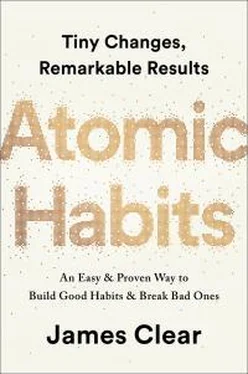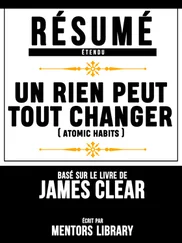The more automatic a behavior becomes, the less likely we are to consciously think about it. And when we’ve done something a thousand times before, we begin to overlook things. We assume that the next time will be just like the last. We’re so used to doing what we’ve always done that we don’t stop to question whether it’s the right thing to do at all. Many of our failures in performance are largely attributable to a lack of self-awareness.
One of our greatest challenges in changing habits is maintaining awareness of what we are actually doing. This helps explain why the consequences of bad habits can sneak up on us. We need a “point-and-call” system for our personal lives. That’s the origin of the Habits Scorecard, which is a simple exercise you can use to become more aware of your behavior. To create your own, make a list of your daily habits.
Here’s a sample of where your list might start:
Wake up
Turn off alarm
Check my phone
Go to the bathroom
Weigh myself
Take a shower
Brush my teeth
Floss my teeth
Put on deodorant
Hang up towel to dry
Get dressed
Make a cup of tea
. . . and so on.
Once you have a full list, look at each behavior, and ask yourself, “Is this a good habit, a bad habit, or a neutral habit?” If it is a good habit, write “+” next to it. If it is a bad habit, write “–”. If it is a neutral habit, write “=”.
For example, the list above might look like this:
Wake up =
Turn off alarm =
Check my phone –
Go to the bathroom =
Weigh myself +
Take a shower +
Brush my teeth +
Floss my teeth +
Put on deodorant +
Hang up towel to dry =
Get dressed =
Make a cup of tea +
The marks you give to a particular habit will depend on your situation and your goals. For someone who is trying to lose weight, eating a bagel with peanut butter every morning might be a bad habit. For someone who is trying to bulk up and add muscle, the same behavior might be a good habit. It all depends on what you’re working toward.*
Scoring your habits can be a bit more complex for another reason as well. The labels “good habit” and “bad habit” are slightly inaccurate. There are no good habits or bad habits. There are only effective habits. That is, effective at solving problems. All habits serve you in some way—even the bad ones—which is why you repeat them. For this exercise, categorize your habits by how they will benefit you in the long run. Generally speaking, good habits will have net positive outcomes. Bad habits have net negative outcomes. Smoking a cigarette may reduce stress right now (that’s how it’s serving you), but it’s not a healthy long-term behavior.
If you’re still having trouble determining how to rate a particular habit, here is a question I like to use: “Does this behavior help me become the type of person I wish to be? Does this habit cast a vote for or against my desired identity?” Habits that reinforce your desired identity are usually good. Habits that conflict with your desired identity are usually bad.
As you create your Habits Scorecard, there is no need to change anything at first. The goal is to simply notice what is actually going on. Observe your thoughts and actions without judgment or internal criticism. Don’t blame yourself for your faults. Don’t praise yourself for your successes.
If you eat a chocolate bar every morning, acknowledge it, almost as if you were watching someone else. Oh, how interesting that they would do such a thing. If you binge-eat, simply notice that you are eating more calories than you should. If you waste time online, notice that you are spending your life in a way that you do not want to.
The first step to changing bad habits is to be on the lookout for them. If you feel like you need extra help, then you can try Pointing-and-Calling in your own life. Say out loud the action that you are thinking of taking and what the outcome will be. If you want to cut back on your junk food habit but notice yourself grabbing another cookie, say out loud, “I’m about to eat this cookie, but I don’t need it. Eating it will cause me to gain weight and hurt my health.”
Hearing your bad habits spoken aloud makes the consequences seem more real. It adds weight to the action rather than letting yourself mindlessly slip into an old routine. This approach is useful even if you’re simply trying to remember a task on your to-do list. Just saying out loud, “Tomorrow, I need to go to the post office after lunch,” increases the odds that you’ll actually do it. You’re getting yourself to acknowledge the need for action—and that can make all the difference.
The process of behavior change always starts with awareness. Strategies like Pointing-and-Calling and the Habits Scorecard are focused on getting you to recognize your habits and acknowledge the cues that trigger them, which makes it possible to respond in a way that benefits you.
Chapter Summary
With enough practice, your brain will pick up on the cues that predict certain outcomes without consciously thinking about it.
Once our habits become automatic, we stop paying attention to what we are doing.
The process of behavior change always starts with awareness. You need to be aware of your habits before you can change them.
Pointing-and-Calling raises your level of awareness from a nonconscious habit to a more conscious level by verbalizing your actions.
The Habits Scorecard is a simple exercise you can use to become more aware of your behavior.
5 The Best Way to Start a New Habit
IN 2001, RESEARCHERS in Great Britain began working with 248 people to build better exercise habits over the course of two weeks. The subjects were divided into three groups.
The first group was the control group. They were simply asked to track how often they exercised.
The second group was the “motivation” group. They were asked not only to track their workouts but also to read some material on the benefits of exercise. The researchers also explained to the group how exercise could reduce the risk of coronary heart disease and improve heart health.
Finally, there was the third group. These subjects received the same presentation as the second group, which ensured that they had equal levels of motivation. However, they were also asked to formulate a plan for when and where they would exercise over the following week. Specifically, each member of the third group completed the following sentence: “During the next week, I will partake in at least 20 minutes of vigorous exercise on [DAY] at [TIME] in [PLACE].”
In the first and second groups, 35 to 38 percent of people exercised at least once per week. (Interestingly, the motivational presentation given to the second group seemed to have no meaningful impact on behavior.) But 91 percent of the third group exercised at least once per week—more than double the normal rate.
The sentence they filled out is what researchers refer to as an implementation intention , which is a plan you make beforehand about when and where to act. That is, how you intend to implement a particular habit.
The cues that can trigger a habit come in a wide range of forms—the feel of your phone buzzing in your pocket, the smell of chocolate chip cookies, the sound of ambulance sirens—but the two most common cues are time and location. Implementation intentions leverage both of these cues.
Broadly speaking, the format for creating an implementation intention is:
“When situation X arises, I will perform response Y.”
Hundreds of studies have shown that implementation intentions are effective for sticking to our goals, whether it’s writing down the exact time and date of when you will get a flu shot or recording the time of your colonoscopy appointment. They increase the odds that people will stick with habits like recycling, studying, going to sleep early, and stopping smoking.
Читать дальше




![Джеймс Клир - Атомные привычки [Как приобрести хорошие привычки и избавиться от плохих]](/books/403243/dzhejms-klir-atomnye-privychki-kak-priobresti-horosh-thumb.webp)



